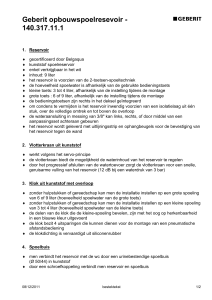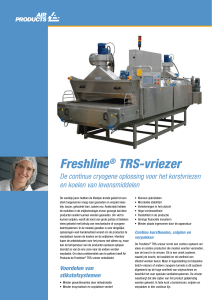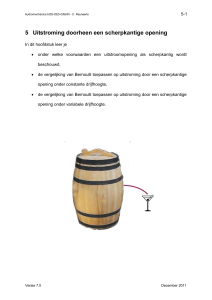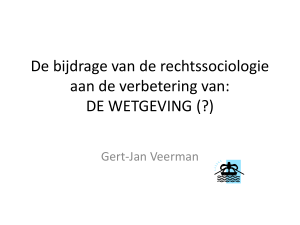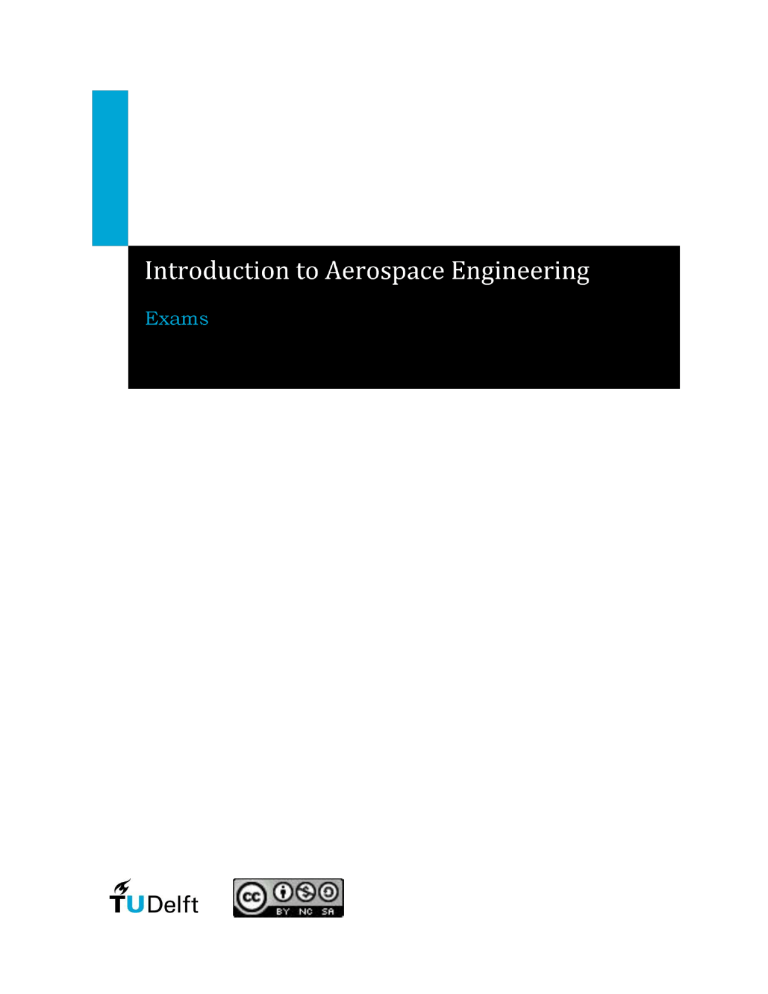
Exam AE1101 Introduction to Aerospace Engineering – Resit January 2010
Go to page 5 for the Dutch version of the exam. Answer in your own preferred language:
English or Dutch. Weight of problem is indicated. In total there are 78 points. Good luck!
Problem 1. (6 pts)
One of the main “laws” in aerospace engineering is to design and build lightweight
vehicles. Why lightweight? Give your answer in 100 words max.
Problem 2 Multiple choice (4 pts)
Which of the following statements about material properties and structural properties is
true? (one answer)
a. The material properties and structural properties are identical
b. The material properties and structural properties are complementary.
c. Structural properties depend on material properties and geometrical features
d. Material properties are much more important than structural properties.
Problem 3 (20 pts)
The figure on the left
shows the temperature
for the standard
atmosphere as a
function of the
geopotential altitude h.
In this problem we
assume the current
atmosphere to precisely
match this ICAO
standard atmosphere.
Conditions at sea level:
p = 1.01325·105 Pa
ρ=1.225 kg/m3
T= 15˚C (288.15 K)
1
To calculate the air pressure in a layer with a linearly varying temperature, we use the
following formula:
where:
p1 ⎛ T1 ⎞
=⎜ ⎟
p0 ⎝ T0 ⎠
−
g0
aR
a) Derive this equation using as a starting point both
the equation of state for an ideal gas: p= ρRT
and the hydrostatic law:
dp = − ρ g 0 dh
With this law and the starting conditions at sea level, the conditions at h = 11 km can be
calculated, they are:
Air pressure: p = 22614 Pa
Air density: ρ = 0.3636 kg/m3
Temperature: T = -56.5˚ C (216.65 K)
A student wants to have a helium filled balloon go even higher, to an altitude of 100,000
ft (30.48 km or FL1000). The molar mass of helium is 4.003 g/mol, for air the molar
mass is 28.97 g/mol. The maximum altitude is determined by the maximum volume
before the balloon bursts.
The material of the balloon is fragile and not elastic, so ignore the pressure difference
before the burst (assume p,T gas = p,T atmosphere). Use the conditions at 11 km as your
starting point and the data in the graph for the calculation of the air density. Note the
isothermal layer with a different formula for the air pressure than the layer where the
temperature varies.
b) Which equation should be used to calculate the net lift of the gas in the balloon?
c) What is the minimum required maximum volume in m3 of the helium balloon to
reach the altitude of FL1000 if the weight of the balloon including payload is
exactly 2 kg (2.000 kg)?
Hint: Note the units!
2
Problem 4 (20 pts)
In a supersonic wind tunnel air flows from a large reservoir via the throat (1) to the test
section (2). For this situation we know:
• Temperature in the reservoir, T0 = 1200 K.
• Pressure in the reservoir p0 = 9 atm
• Temperature in the test section T2 = 310 K
• Mass flow = 0.5 kg/s
• Specific heat coëfficiënt cp = 1008 J/kg K
• The ratio of specific heat coefficients γ = c p c v = 1.4
a) Calculate the air temperature in the throat (1)
Note: - use the energy equation,
- use the formulation for the speed of sound in (1) containing the temperature
- use R calculated from R = c p − cv
or just use the second form of the isentropic relations containing the Mach
number.
b) Calculate the airspeed in the throat (1). If you did not succeed in deriving the
temperature in a) take T1= 900 K for this calculation.
c) Calculate the Mach number in the test section (2)
d) Calculate the area of the throat cross section (1)
(Note: first calculate ρ0)
Reservoir
Throat
Te
P0
T0
(1)
(2)
Supersonic wind tunnel
3
Test section
Problem 5. (20 pts)
No gravity
Consider a spacecraft (lander) with a total mass M0 =1000 kg in the absence of gravity.
The exhaust velocity of the propulsion system equals Ve =2000 m/sec.
a) Determine the amount of propellant Mp [kg] required to provide a change in the
velocity of the spacecraft of 500 m/sec.
b) The same question but obtained by an instantaneous (time duration ∆t =0)
momentum change due the exhaust of all propellant at once.
c) Explain the difference in the answers of questions a) and b).
With gravity
The lander lifts off from an exoplanet without atmosphere with constant gravity
acceleration g = 10 m/sec2. Starting at t0 = 0, after 10 seconds a velocity V1 = 10 m/sec is
obtained at a height h1 =100 meter. The propulsion system delivers a constant
acceleration.
d) Determine the total constant acceleration a [m/sec2] of the spacecraft.
e) Determine the thrust force [kN] at t=0.
Problem 6 (8 pts):
The picture below shows the behaviour of the orbit altitude of the Russian space station
Mir and the German research satellite GFZ-1. Discuss four aspects of its content
(similarities, differences).
4
Tentamen AE110 Introduction to Aerospace Dutch version – Herkansing Jan 2010
Beantwoord de vragen in de taal van je keuze: Engels of Nederlands, los van in welke
groep je zit. Het gewicht staat per opgave aangegeven, in totaal zijn dat 78 punten.
Succes!
Opgave 1 (6 punten)
Een van de hoofdregels in aerospace engineering is om lichtgewicht voertuigen te
ontwerpen en bouwen. Waarom lichtgewicht? Geef je antwoord in maximaal 100
woorden.
Opgave 2 Multiple choice (4 punten)
Welke van de volgende beweringen over materiaal en constructie eigenschappen is juist?
(één antwoord)
a. De materiaal eigenschappen en de constructie eigenschappen zijn aan elkaar
gelijk (identiek)
b. De materiaal eigenschappen en de constructie eigenschappen vullen elkaar aan
c. De constructie eigenschappen zijn afhankelijke van de materiaal eigenschappen
en geometrische kenmerken
d. Materiaal eigenschappen zijn veel belangrijker dan constructie eigenschappen.
Opgave 3 (20 punten)
Hiernaast staat de
grafiek met het
temperatuurverloop in
de standaardatmosfeer
als functie van de
geopotentiaalhoogte h.
In deze som nemen we
aan dat de atmosfeer
precies overeenkomt
met deze ICAO
standaardatmosfeer.
Condities op zeeniveau:
p = 1,01325·105 Pa
ρ=1,225 kg/m3
T= 15˚C (288,15 K)
5
Voor het berekenen van de druk in een laag met een lineair verlopende temperatuur
gebruiken we de volgende formule:
p1 ⎛ T1 ⎞
=⎜ ⎟
p0 ⎝ T0 ⎠
−
g0
aR
a) Leid dit verband af uit:
de ideale toestandsgaswet:
en de hydrostatische wet:
p= ρRT
dp = − ρ g 0 dh
Met deze wet en de begincondities op zeeniveau is te berekenen dat op 11 km hoogte de
volgende condities gelden:
Luchtdruk: p = 22614 Pa
Luchtdichtheid: ρ = 0,3636 kg/m3
Temperatuur: T = -56,5˚ C (216,65 K)
Iemand wil een heliumballon oplaten die nog hoger gaat, namelijk tot 100,000 ft (30.48
km ofwel FL1000). De molaire massa van helium is 4.003 g/mol, van lucht 28.97 g/mol.
De maximale hoogte wordt bepaald door het maximale volume voordat de ballon barst.
Het materiaal van de ballon is kwetsbaar en erg dun, dus negeer de drukopbouw vlak
voor het scheuren (neem aan dat p,T gas = p,T atmosfeer). Gebruik de condities op 11 km
hoogte als startpunt samen met gegevens in de grafiek voor het berekenen van de
luchtdichtheid. Let erop dat voor de isothermische laag een ander verband geldt voor de
druk dan voor de laag waar de temperatuur varieert.
b) Welke vergelijking kun je hier gebruiken om de netto lift van het gas in de ballon
te berekenen?
c) Wat is het minimaal benodigde maximum volume in m3 van de heliumballon om
die hoogte van FL1000 te kunnen halen als het gewicht van de ballon inclusief de
payload op de gram af 2 kg is (dus 2,000 kg)?
Tip: let op eenheden!
6
Opgave 4 (20 punten)
Bij een supersone windtunnel wordt lucht uit een groot reservoir via een keel (1) naar de
testsectie (2) geleid.
Gegeven:
• Temperatuur in het reservoir, T0 = 1200 K.
• Druk in het reservoir p0 = 9 atm.
• Temperatuur in de testsectie T2=310 K.
• Massastroom = 0,5 kg/s.
• Specifieke warmtecoëfficiënt cp = 1008 J/kg K
• De verhouding van de specifieke warmte coëfficiënten γ = c p cv = 1, 4
Gevraagd:
a) Bereken de luchttemperatuur in de keel (1).
- gebruik de energie vergelijking
- gebruik de formule voor de geluidssnelheid in (1) met daarin de
temperatuur
- gebruik R berekend uit R = c p − cv
Of gebruik de tweede vorm van de formules voor de isentropische relaties met
daarin het Mach getal M.
b) Bereken de luchtsnelheid in de keel (1). Als u er bij a) niet in bent geslaagd de
temperatuur te berekenen, gebruik dan hier T1=900 K.
c) Bereken het Mach getal in de testsectie (2)
d) Bereken de oppervlakte van de doorsnede van de keel(1)
(Hint: bereken eerst de dichtheid ρ0)
7
Opgave 5 (20 punten)
Geen zwaartekracht
Beschouw een ruimtevaartuig (lander) met totale massa M0 =1000 kg in afwezigheid van
zwaartekracht. De uitstootsnelheid van het voortstuwingssysteem bedraagt Ve =2000
m/sec.
a) Hoeveel stuwstof Mp [kg] is nodig voor een snelheidsverandering ∆V=500 m/sec.
b) Zelfde vraag voor een instantane (tijdsduur ∆t =0) uitstoot van de gehele stuwstof
massa. (Hint: Denk aan impuls)
c) Leg uit en waarom er verschil is in het antwoord op a) en b) en verklaar dit.
Wel zwaartekracht
De lander stijgt op van een exoplaneet zonder atmosfeer met constante
gravitatieversnelling g = 10 m/sec2. Startend op t0 = 0 wordt in 10 seconden een snelheid
V1 = 10 m/sec verkregen op hoogte h1 =100 meter. Er wordt een constante versnelling
geleverd door het voortstuwingssysteem.
d) Bepaal de totale eenparige versnelling a [m/sec2]
e) Bepaal de voortstuwingskracht [kN] op t=0
Opgave 6 (8 punten)
De figuur hieronder toont het gedrag van de baanhoogte van het Russische ruimtestation
Mir en de Duitse onderzoekssatelliet GFZ-1. Bespreek 4 aspecten van wat je uit deze
figuur afleest (overeenkomsten, verschillen).
8

